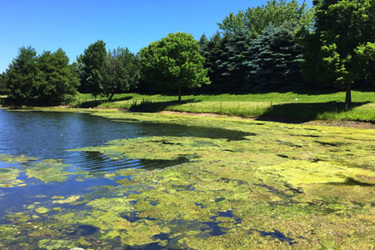Does Your Waterbody Need A Doctor?

By Kevin Westerling,
@KevinOnWater

Just as you go to the doctor in the case of a bacterial infection — typically resolved with a round of antibiotics along with monitoring to assess symptoms and tests to prove good health — your lake or waterbody must be treated similarly for its bacteria problem. It’s not one pill and then you’re cured.
Lucia Ross, CMO of BlueGreen Water Technologies, which specializes in nursing waterbodies impacted by harmful algal blooms (HABs) back to health, described the company’s approach to remediation:
“Blue-green algae is not true algae, but rather a bacteria. Therefore, a blue-green algal bloom is essentially a bacterial infection in water. So, in order to treat it, we develop a treatment plan for water in the same way your doctor develops a treatment plan for you if you have a bacterial infection. We're not going to indiscriminately dump tons of chemicals in the water and say, ‘There, we're done. It's going to be fine.’ We don't do that. We don’t want to do that. We do what a doctor does. We perform a checkup first. We need to monitor the water with everything from in situ monitoring, satellite imaging, and drone photography. We then need to look at the history of the lake and go back and analyze the gathered data with our water scientists and say, ‘Okay, what does this water body have? How much bacteria does it have? Where and when are we going to treat? Which products are we going to use? And how often do we need to treat?’”
The ‘infection’ in the case of the world’s waterways is the plague of HABs, which is being exacerbated by climate change — HABs thrive in warm water with sunlight — and the volume of nutrients (phosphorus and nitrogen) that enter the water from agricultural/fertilizer runoff, point source discharges, faulty septic tanks, or natural sources such as leaves, grass, or animal excrement. Once the conditions are set, HABs can take over a water system rapidly, generating toxic cyanobacteria that is harmful to marine life as well as humans and their pets, and could even wind up in drinking water.
The scope of the problem is significant, as Ross explained:
“HABs used to be an issue that was prevalent primarily in warm-weather climates. Now you see it in all 50 states and across the globe. Global warming is playing a part because the temperature is rising, which is accelerating surface water evaporation and causing droughts to occur more frequently and be more intense. When you have a shallower pool of water, the water heats up more quickly and that allows for the bacteria to grow a much faster rate. They grow exponentially. A colony can double in size every five to seven hours.
“So, if you look outside and you say, ‘Oh, there's some growing out there,’ and you go to sleep and the next day you wake up, it'll be twice as big or more. I mean, they are great at what they do. They've been around for millions of years longer than we have, and I'm sure they'll be here long after. And they will take over a waterbody before you know it.”
For BlueGreen Technologies, the prescription to remediate a waterbody will depend on the specific characteristics of the water and surrounding environment. All of their treatments, however, are easy to apply and environmentally friendly.
“When we remediate the waterbody, we aren't trying to bleach the water column,” noted Ross. “We’re trying to bring a waterbody back into balance to allow helpful green algae and other organisms that live within the water to be able to compete. That's the whole thing.”
And although we’re heading into winter, when blooms are scant, it’s the perfect time to address the issue.
“It doesn't have to happen every year,” said Ross. “We have an environmentally safe solution that allows you to get rid of this bloom within hours to days, and keep it gone with a proper remediation schedule. Just because it's wintertime and you can no longer see the worst of it, they haven't disappeared. Again, cyanobacteria have been around for millions of years. They're just laying low. It's not as hot on the surface, so they're just down lower in the water column.
“It’s actually the best time to treat, before it starts. A lot of times, it will be ‘out of sight, out of mind’ for municipalities. If it's not blooming and citizens aren't complaining, they don't want to throw money at the problem; but when there are fewer cells and cyanobacteria is at its weakest, it's the best time to do it. It's not blooming and no one's complaining, but we've taken measurements and we see over 20,000 cells per milliliter, which, by EPA standards, means the water is toxic. Why don't we hit it now while you're not seeing anything, while you're not smelling anything, so it stays this way. And, to boot, it really will be non-toxic water because we'll keep cell counts low.”
If your waterbody is ailing due to harmful algal blooms, consider contacting BlueGreen Water Technologies to schedule a checkup.
